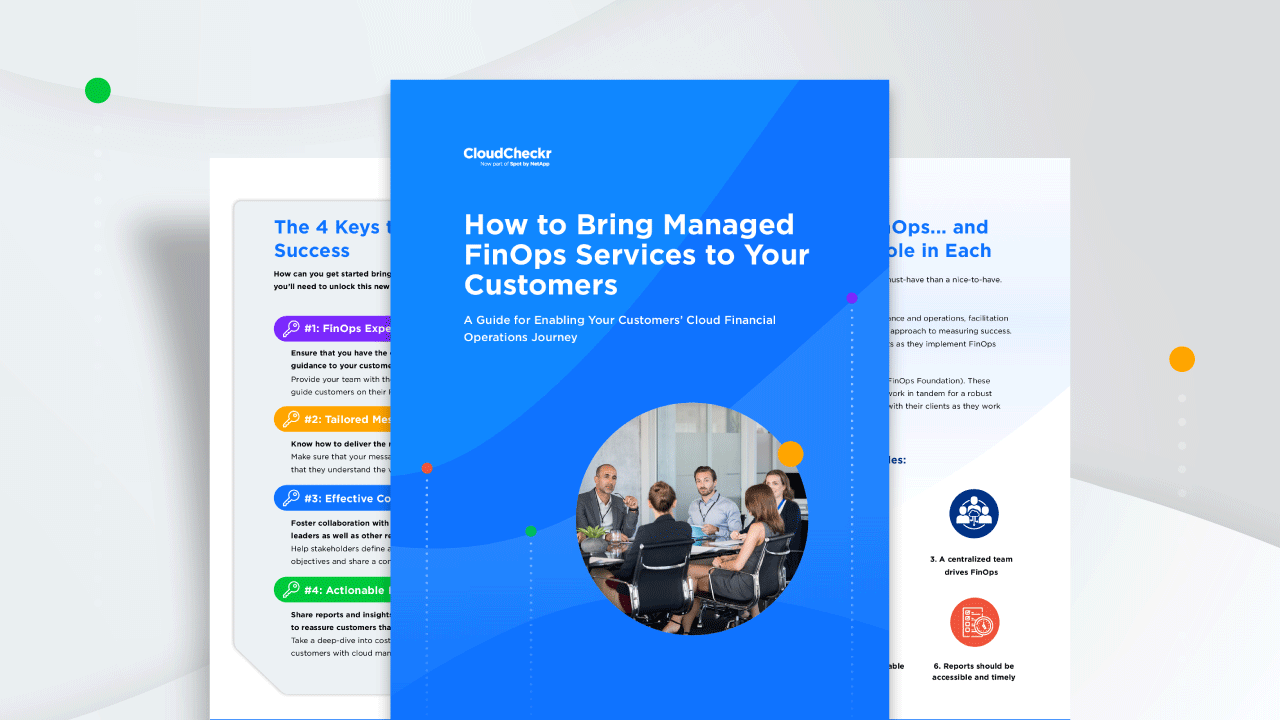For many organizations, FinOps is becoming more of a must-have than a nice-to-have. But they can’t do it alone.
Effective FinOps requires strategic expertise in cloud finance and operations, facilitation between disparate business functions, and a data-driven approach to measuring success. MSPs can help their customers with each of these aspects as they implement FinOps oversight and level-up their cloud financial management.
The FinOps Foundation developed six key principles of a comprehensive FinOps practice that organizations can implement. These principles can be approached in any order, and all must work in tandem for a robust FinOps practice. MSPs can become an essential partner with their clients as they work together to achieve the goals of the FinOps principles.
How can you put these guidelines into practice? Here are the six FinOps Principles and the steps that MSPs can take to bring them to customers.
1. Everyone takes ownership for their cloud usage
When everyone shares the responsibility of managing cloud spend, individual teams must track and manage their own cloud usage against their budget. MSPs can help customers follow best practices that bring increased visibility into their cloud spend — at both macro and micro levels.
One of the first tasks is to define best practices, governance, and workflows around cloud utilization, optimization, and anomalies. MSPs can lead by example by determining what success looks like and establishing and monitoring KPIs and metrics. Cloud usage and cost should be mapped to the appropriate cost centers through an effective tag management strategy. This will help forecast future cloud needs and costs when you present reports to your customers.
2. Teams need to collaborate
FinOps brings together finance and cloud operations teams, which includes IT, engineering, and other functions. All of these teams must work together to continuously improve cloud governance and finances. That means sharing a common language around finance and cloud terminology.
MSPs can help foster this collaboration by ensuring that all users have access to the right information and controls for their cloud environment. Using cloud management tools, MSPs can offer always-on dashboards for cloud costs and utilization aligned with business defined metrics, with the ability to view and analyze granular costs. They can also help train stakeholders, build knowledge bases, and inform team members on their progress and opportunities to help continue fostering that teamwork.
3. A centralized team drives FinOps
While FinOps is everybody’s job, much like the shared responsibility of cloud security, there is still a need for leadership to oversee operations. A centralized team guiding FinOps practices provides cohesive governance that can help cloud practitioners across all relevant business functions understand the variable costs of the cloud and take responsibility for their cloud spend.
Having a central team to provide that oversight is a good first step. MSPs can be instrumental in helping their customers establish a FinOps Center of Excellence from the ground up or integrating FinOps into the customer’s existing Cloud Center of Excellence.
Enhance your customers’ FinOps practices
Get the essential checklists to bring all 6 FinOps Principles to your customers.
Download the White Paper

4. Decisions are driven by business value of cloud
Once the FinOps team members have been selected, they need to make decisions that tie the value of the cloud to the organization’s business goals. As part of this process, this team will also analyze costs, develop benchmarks that drive best practices, and determine the overall performance of FinOps efforts.
One way to begin developing performance metrics is by looking at the FinOps “Iron Triangle.” This model assesses tradeoffs and resource sharing opportunities against the categories of speed, cost, and quality. MSPs should also help their customers track cloud performance costs and improvements and tie them back to their impacts on business outcomes, such as customer satisfaction.
5. Take advantage of the variable cost model of the cloud
The cloud presents unique opportunities to your customers in terms of capacity planning. As their service provider, you can help customers make more informed decisions around cloud cost optimization and resource utilization to get the most out of their cloud investment.
MSP subject matter experts can help guide customers cloud purchasing strategies. The MSP’s centralized cloud volume buying power helps customers optimize discount purchase opportunities, such as committed use discounts (e.g., reserved instances, spot instances, and Savings Plans).
6. Reports should be accessible and timely
MSPs have a variety of cloud management solutions at their disposal and should generate reports from the data that these tools collect. Giving customers this information, in easily consumable reports, brings insight and visibility into their resource utilization and provides a fast, consistent feedback loop to drive efficiency in their cloud practice.
Cloud management tools give the MSP the ability to create and deliver reports in near-real time. These reports — which may be weekly, monthly, or quarterly — can break down cloud spend, cost allocation, resource utilization, security and compliance data, and more. The appropriate cadence for reporting and accessibility may be based on industry best practices as well as customer needs. MSPs should survey stakeholders on a periodic basis to ensure that reporting addresses business needs and provides actionable recommendations.
Crawl, Walk, Run
Of course, applying these FinOps Principles will be different depending upon where your customers are in the FinOps journey. The FinOps Foundation rates the maturity of a FinOps practice according to three stages: Crawl, Walk, and Run. It’s important that MSPs conduct this assessment first to determine what guidance the customer needs in implementing, maturing, and optimizing their FinOps practice.
At the Crawl stage, engineers may not be familiar with FinOps and how they can play a role in it. Leadership may not yet see the value of FinOps yet either. In this early stage, the MSP can help bridge the gaps between finance and engineering to ensure collaboration.
At the Walk stage, leadership understands the importance of FinOps and makes decisions based on the FinOps Iron Triangle. Engineering and Finance are aware of each others goals and actively engage in FinOps processes. However, stakeholders may see FinOps metrics as “just another operational metric,” according to the FinOps Foundation. MSPs can help customers incorporate FinOps methodologies into wider business goals.
Finally, at the Run stage, the organization’s FinOps practice has reached an advanced level of maturity. Engineers consider the financial impact during each life-cycle and actively look for FinOps opportunities. MSPs can support customers in this stage by ensuring that they continuously monitor and optimize their cloud financial performance.
Thinking Beyond the FinOps Frameworks
“A framework is one thing,” said our recent webinar guest Benjamin van der Maas, Cloud Financial Management Practice Lead at Cloudar and founder of the FinOps Alliance. “How you do it in the real world, how you bring it into practice, that’s another thing.”
Watch our latest webinar on the Six Principles of FinOps to learn how Cloudar embraces FinOps and how the FinOps Alliance is bringing real-life FinOps experience to the table.
Learn FinOps basics and best practices
Catch all three parts of our FinOps webinar series on-demand.
Watch Now

Cloud Resources Delivered
Get free cloud resources delivered to your inbox. Sign up for our newsletter.
Cloud Resources Delivered
Subscribe to our newsletter
